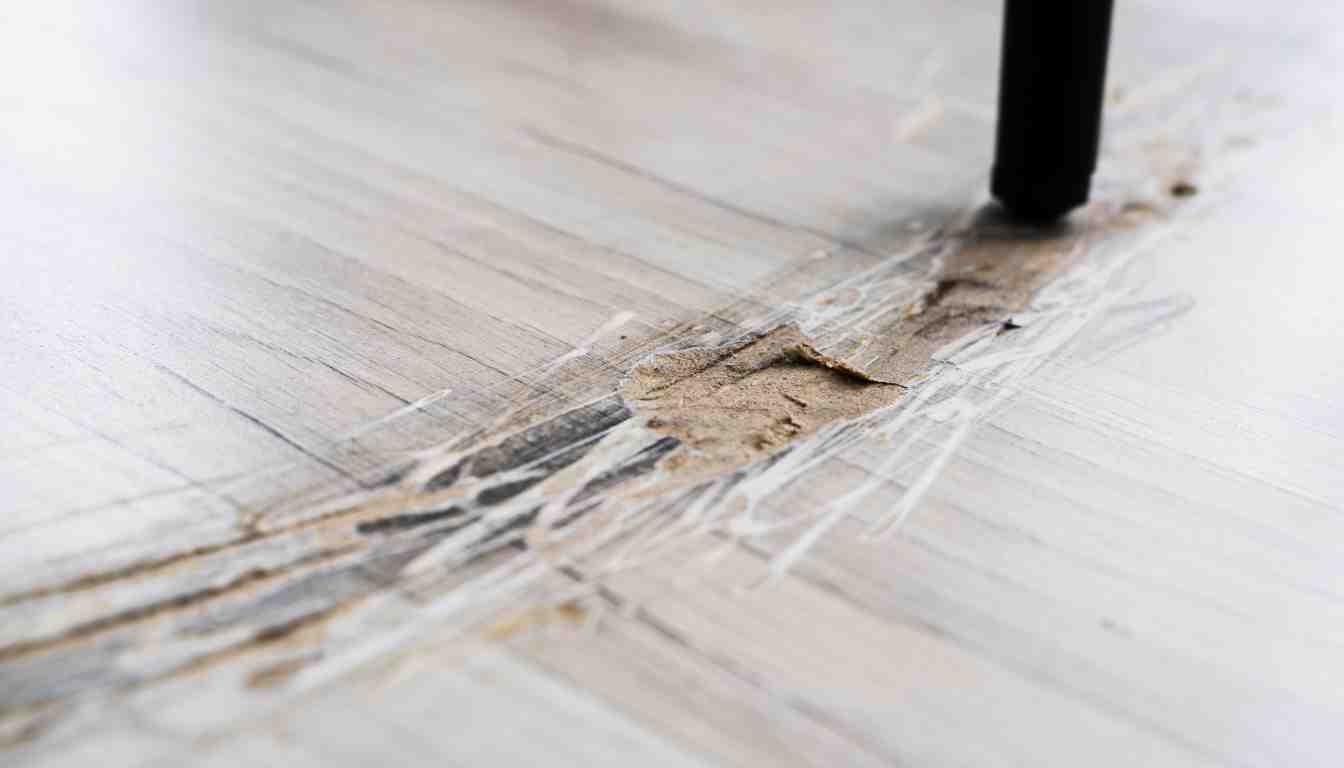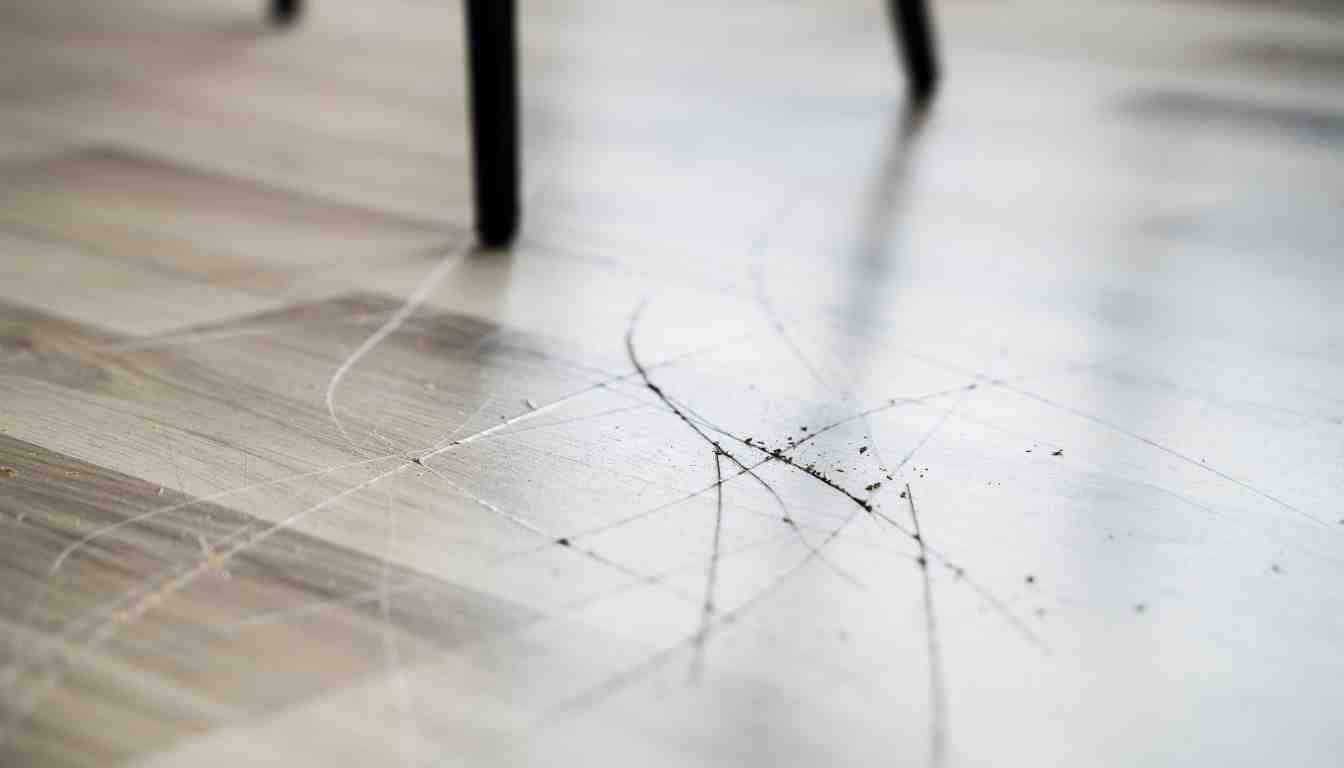To repair scratched laminate flooring, use a laminate floor repair kit or apply a laminate floor filler matched to the color of your flooring. Laminate flooring is a popular choice for its durability and easy maintenance.
However, over time, scratches may appear, marring its appearance. If you are wondering how to repair scratched laminate flooring, you have come to the right place. We will discuss effective methods to help you restore the pristine look of your laminate floor.
Whether you opt for a laminate floor repair kit or a laminate floor filler, you can easily fix the scratches and maintain the beauty of your flooring. Keep reading to learn step-by-step instructions on repairing scratches on laminate flooring.
Understanding Laminate Flooring
Laminate flooring provides a durable and affordable option for your home, but scratches can mar its appearance. Learn how to effectively repair scratched laminate flooring to restore its original beauty. With a few simple steps, you can easily fix minor scratches and keep your laminate flooring looking pristine.
Laminate flooring is a popular choice for many homeowners due to its affordability, durability, and wide range of styles and designs. It is made up of multiple layers, each serving a specific purpose to ensure its strength and longevity. The top layer consists of a protective finish that helps resist scratches and stains. The core layer is made of high-density fiberboard (HDF) or medium-density fiberboard (MDF) to provide stability and support. The bottom layer acts as a moisture barrier to protect the flooring from water damage.

What Is Laminate Flooring?
Laminate flooring is a synthetic flooring material that mimics the appearance of hardwood, tile, or stone. It is composed of several layers that are fused together through a lamination process. The top layer, also known as the wear layer, is designed to withstand daily wear and tear. It is typically made of resin-based melamine or aluminum oxide, which provides resistance against scratches, fading, and stains. Beneath the wear layer is the decorative layer, featuring a high-resolution image of the desired flooring design. This layer gives laminate flooring its realistic look. The core layer, made of HDF or MDF, adds strength and stability to the flooring. Finally, the bottom layer serves as a moisture barrier, preventing water or moisture from seeping into the flooring and causing damage.
Common Causes Of Scratches On Laminate Flooring
Scratches are an unfortunate reality of having laminate flooring. While laminate is known for its durability, it is still susceptible to scratches under certain conditions. Understanding the common causes of scratches can help you prevent them and maintain the beauty of your laminate flooring.
1. Furniture movement: Dragging heavy furniture across the laminate flooring can leave unsightly scratches. Always use furniture pads or felt protectors to prevent direct contact between the furniture and the floor.
2. Pet claws: If you have pets with long nails, their claws can easily scratch the laminate surface. Regularly trim your pet’s nails and consider using pet-friendly floor protectors to minimize the risk of damage.
3. Grit and dirt: Small particles of dirt, sand, or gravel can act like sandpaper on your laminate flooring, causing scratches over time. It is essential to keep the floors clean by regularly sweeping or vacuuming. Additionally, placing doormats at entrances can help trap dirt and prevent it from being tracked onto the laminate surface.
4. Improper cleaning tools: Using abrasive cleaning tools such as steel wool or stiff bristle brushes can scratch the top layer of laminate flooring. Stick to soft microfiber mops or damp mopping with gentle cleaners specifically designed for laminate floors.
5. High heels and footwear: High heels or shoes with sharp, abrasive soles can leave marks and scratches on the laminate surface. Consider using designated indoor slippers or footwear with softer soles inside your home.
By understanding the nature of laminate flooring and the common causes of scratches, you can take proactive measures to prevent damage to your floors. Implementing preventive measures, such as using furniture pads, regular cleaning, and being mindful of footwear choices, can go a long way in keeping your laminate flooring looking its best.
Identifying The Severity Of Scratches
Scratches on laminate flooring can be a real eyesore, but before you jump into repair mode, it’s essential to identify the severity of the scratches to determine the best course of action. By understanding the difference between surface scratches and deep scratches, you can effectively repair your laminate flooring and restore its beauty. Let’s dive into each type of scratch and how to deal with them.
Surface Scratches
Surface scratches are the most common type of damage that your laminate flooring may experience. These scratches are usually shallow and only affect the protective layer of the laminate. Although they may be unsightly, the good news is that surface scratches can be easily repaired with minimal effort. Here are some steps you can take to fix surface scratches:
- Clean the scratched area: Start by clearing away any dirt or debris from the scratched surface. Use a vacuum cleaner or a soft cloth to ensure a clean and debris-free area.
- Apply a laminate repair kit: Laminate repair kits are readily available in most hardware stores and online. These kits typically include a putty-like substance that matches the color of your laminate flooring. Apply the putty to the scratch, following the kit instructions carefully.
- Smooth the repaired area: Once the putty has dried, gently sand the area with fine-grit sandpaper until it becomes smooth and blends in with the rest of the floor. Be careful not to sand too aggressively, as this can cause further damage.
- Buff the floor: Finally, use a soft cloth to buff the repaired area, giving it a polished finish. This step will help the repaired area blend seamlessly with the rest of the floor.
Deep Scratches
Deep scratches on laminate flooring are a bit more challenging to repair compared to surface scratches. These scratches penetrate deeper into the laminate and can expose the underlying layers, making them more noticeable. If your floor has deep scratches, follow these steps to restore its appearance:
- Clean the scratch: Just like with surface scratches, start by cleaning the scratched area to remove any dirt or debris.
- Fill the scratch: Fill the scratch with a wood filler that matches the color of your laminate flooring. Use a putty knife or a small spatula to apply the filler, ensuring it fills the scratch completely.
- Remove excess filler: Scrape off any excess filler from the surface of the floor using the putty knife, making it flush with the surrounding area.
- Sand and blend: Once the filler has dried, use fine-grit sandpaper to smooth the repaired area. Sand gently in a circular motion until the filled area blends in with the rest of the floor.
- Seal the area: To protect the repaired area from future damage, apply a laminate sealant over the repaired spot. This will help maintain the integrity of the repair and prevent moisture from seeping into the laminate.
By identifying the severity of scratches on your laminate flooring, you can take the appropriate steps to restore its appearance. Whether you’re dealing with surface scratches or deep scratches, following the correct repair techniques will ensure that your laminate flooring looks as good as new.
Simple Solutions For Repairing Scratched Laminate Flooring
When it comes to maintaining the beauty of your laminate flooring, scratches can be a nuisance. Fortunately, there are simple and effective solutions available to repair those unsightly scratches. Whether you prefer quick fixes or want to replace damaged planks, we have got you covered. Read on to discover the easiest ways to repair scratched laminate flooring.
Using Wax Or Floor Polish
If you have minor scratches on your laminate flooring, using wax or floor polish can be an excellent solution. Wax and floor polish are designed to fill in the scratches and create a protective coating on the surface, making them less noticeable. Here’s how you can do it:
- Clean the scratched area with a damp cloth to remove any dirt or debris.
- Apply the wax or floor polish onto the scratch, following the product instructions.
- Gently buff the area with a soft cloth, blending the treatment with the surrounding flooring.
- Allow the wax or floor polish to dry completely and then give it a final polish for a seamless finish.
Using A Laminate Floor Repair Kit
For more substantial scratches or damage, a laminate floor repair kit can provide a comprehensive solution. These kits usually contain everything you need to repair scratches and restore the appearance of your laminate flooring. Follow these steps to utilize a laminate floor repair kit:
- Clean the scratched area with a mild cleaner and a cloth to ensure there is no dirt or debris.
- Using the provided spatula, apply the putty or filler from the repair kit into the scratch.
- Smooth out the filler with the spatula, following the grain pattern of the laminate flooring.
- Allow the filler to dry thoroughly according to the product instructions.
- Finally, use a fine-grit sandpaper (provided in the kit) to smooth out the repaired area and blend it seamlessly with the surrounding flooring.
Blending In Scratches With A Matching Laminate Marker
For minor scratches that are highly visible, a laminate marker can be a quick and efficient solution. These markers come in various shades to match most laminate floor colors. Here’s how you can blend scratches using a laminate marker:
- Clean the scratched area with a damp cloth to remove any dirt.
- Select a laminate marker that closely matches the color of your flooring.
- Using gentle strokes, apply the marker to the scratch until it is adequately covered.
- Wipe off any excess marker using a cloth.
- Allow the marker to dry, and if needed, repeat the process until the scratch is no longer visible.
Replacing Damaged Laminate Planks
In some cases, when the scratches or damage to your laminate flooring are extensive, replacing the damaged planks might be the best solution. Here’s a simple guide to help you replace damaged laminate planks:
- Identify the damaged planks and carefully remove them by lifting them from the edges.
- Measure and cut a replacement plank of the same size to ensure a seamless fit.
- Fit the replacement plank into the vacant space, ensuring it aligns with the surrounding flooring.
- Secure the new plank by clicking or locking it into place with the existing flooring.
- Gently tap along the edges with a rubber mallet to ensure a tight fit.
By following these simple solutions, you can effectively repair scratched laminate flooring and restore its original beauty. Whether you choose to use wax, a laminate floor repair kit, a matching laminate marker, or opt for replacing damaged planks, these solutions provide you with the necessary tools to keep your laminate flooring looking flawless.

Prevention And Maintenance Tips
When it comes to maintaining your laminate flooring and preventing scratches, a little bit of effort can go a long way. By following these simple prevention and maintenance tips, you can keep your laminate flooring as good as new for years to come.
Using Furniture Pads
Using furniture pads is an effective way to prevent scratches on your laminate flooring. These pads act as a cushion between your furniture and the floor, reducing the chances of any damage. Place furniture pads on the legs of tables, chairs, sofas, and any other heavy furniture items that come in direct contact with your laminate flooring.
Regular Cleaning And Care
Regularly cleaning and caring for your laminate flooring not only keeps it looking pristine but also helps in preventing scratches. Begin by removing dust and dirt with a soft-bristled broom or vacuum cleaner. Avoid using hard-bristled brushes that may leave scratches. Next, dampen a microfiber mop or cloth with water and a mild cleaner specifically designed for laminate floors. Gently remove any stains or spills, ensuring the mop or cloth is not overly wet. Finally, dry the floor thoroughly with a clean, dry cloth to prevent standing water from seeping into the laminate and causing damage.
Avoiding Sharp Objects
Avoid using sharp objects directly on your laminate flooring to prevent scratches. Sharp objects such as high-heeled shoes, pet claws, and heavy-duty kitchen utensils can easily create unsightly marks. Always be mindful of what you place on your floors and encourage others to do the same. Consider using protective pads or rugs in high-traffic areas to further reduce the risk of scratches.
Taking Precautions During Moving Furniture
Moving furniture, especially heavy pieces, can be a potential hazard to your laminate flooring. To avoid scratches during this process, take some simple precautions. Start by enlisting the help of a friend or using furniture sliders to lessen the friction between the furniture and the floor. Lift furniture instead of dragging it across the laminate. If lifting is not an option, use a thick blanket or rug under the furniture to provide a protective barrier.
Conclusion
To conclude, repairing scratched laminate flooring doesn’t have to be a daunting task. By following the simple steps discussed in this blog post, you can easily restore the appearance of your laminate flooring and prolong its lifespan. Remember to gather the necessary materials, prepare the surface, apply the appropriate repair method, and protect the repaired area to ensure long-lasting results.
Keep your laminate flooring looking as good as new with these effective repair techniques.


